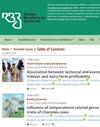Effect of milking hygiene, herd size, water hardness and temperature-humidity index on milk quality of dairy farms
IF 1.2
4区 农林科学
Q3 Agricultural and Biological Sciences
Revista Brasileira De Zootecnia-Brazilian Journal of Animal Science
Pub Date : 2023-05-12
DOI:10.37496/rbz5220210189
引用次数: 0
Abstract
- The objective of this study was to evaluate the effect of milking hygiene practices, herd size, water hardness, and temperature-humidity index (THI) on the physicochemical and microbiological characteristics of raw milk, and standard plate count (SPC) in milking machines of dairy farms in the central region of Mexico. Data were collected from fifty-three dairy farms during one year. The evaluated effects included milking hygiene conditions (good, medium, poor), herd size (1-50, 51-100, 101-150, ≥151 heads), water hardness (soft or moderately hard), and THI (comfortable or stressful). The increase in milking hygiene produced greater milk yield (MY) and energy corrected milk (ECM) but lower protein content, and decreased the individual bacterial count (IBC) and somatic cell count (SCC). The MY, ECM, protein content, IBC, and SCC were higher on bigger farms. The use of soft water reduced MY, IBC, and SCC, but improved fat, lactose, total solids (TS), and non-fat solids (NFS). Heat stress negatively affected fat, protein, TS, NFS, acidity, freezing point (FP), SCC, and methylene blue dye reduction test. Poor milking hygiene contributes to higher SPC in milking machine parts. Water hardness and THI did not affect SPC in all milking machine parts. Proper milking hygiene practices, larger herd size, softer water, lower THI, and adequate cleaning and disinfection of the milking machine parts benefits the physicochemical and microbiological quality of the milk.挤奶卫生、畜群规模、水硬度和温湿指数对奶牛场牛奶品质的影响
本文章由计算机程序翻译,如有差异,请以英文原文为准。
求助全文
约1分钟内获得全文
求助全文
来源期刊
CiteScore
1.90
自引率
0.00%
发文量
25
审稿时长
8 weeks
期刊介绍:
The Revista Brasileira de Zootecnia (RBZ; Brazilian Journal of Animal Science) encompasses all fields of Animal Science Research. The RBZ publishes original scientific articles in the areas of Aquaculture, Biometeorology and Animal Welfare, Forage Crops and Grasslands, Animal and Forage Plants Breeding and Genetics, Animal Reproduction, Ruminant and Non-Ruminant Nutrition, and Animal Production Systems and Agribusiness.

 求助内容:
求助内容: 应助结果提醒方式:
应助结果提醒方式:


